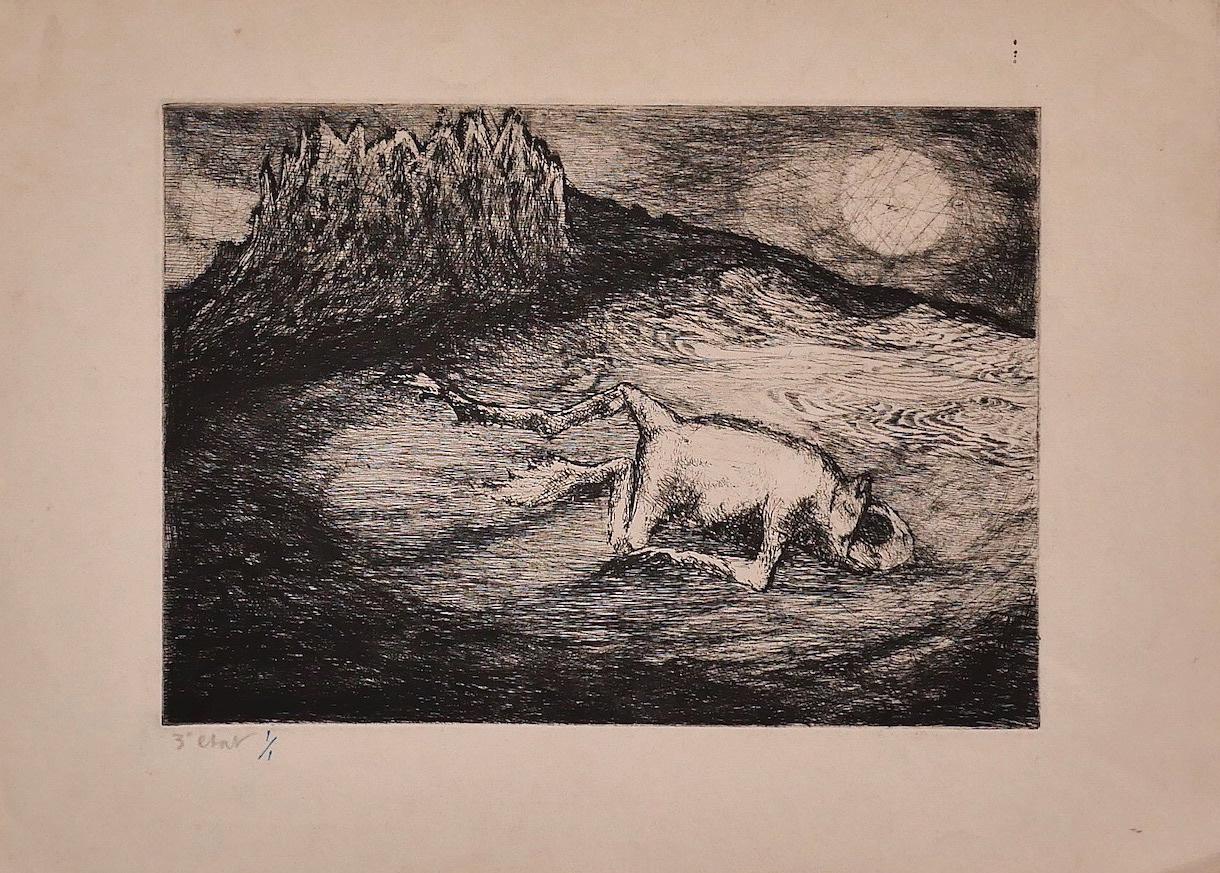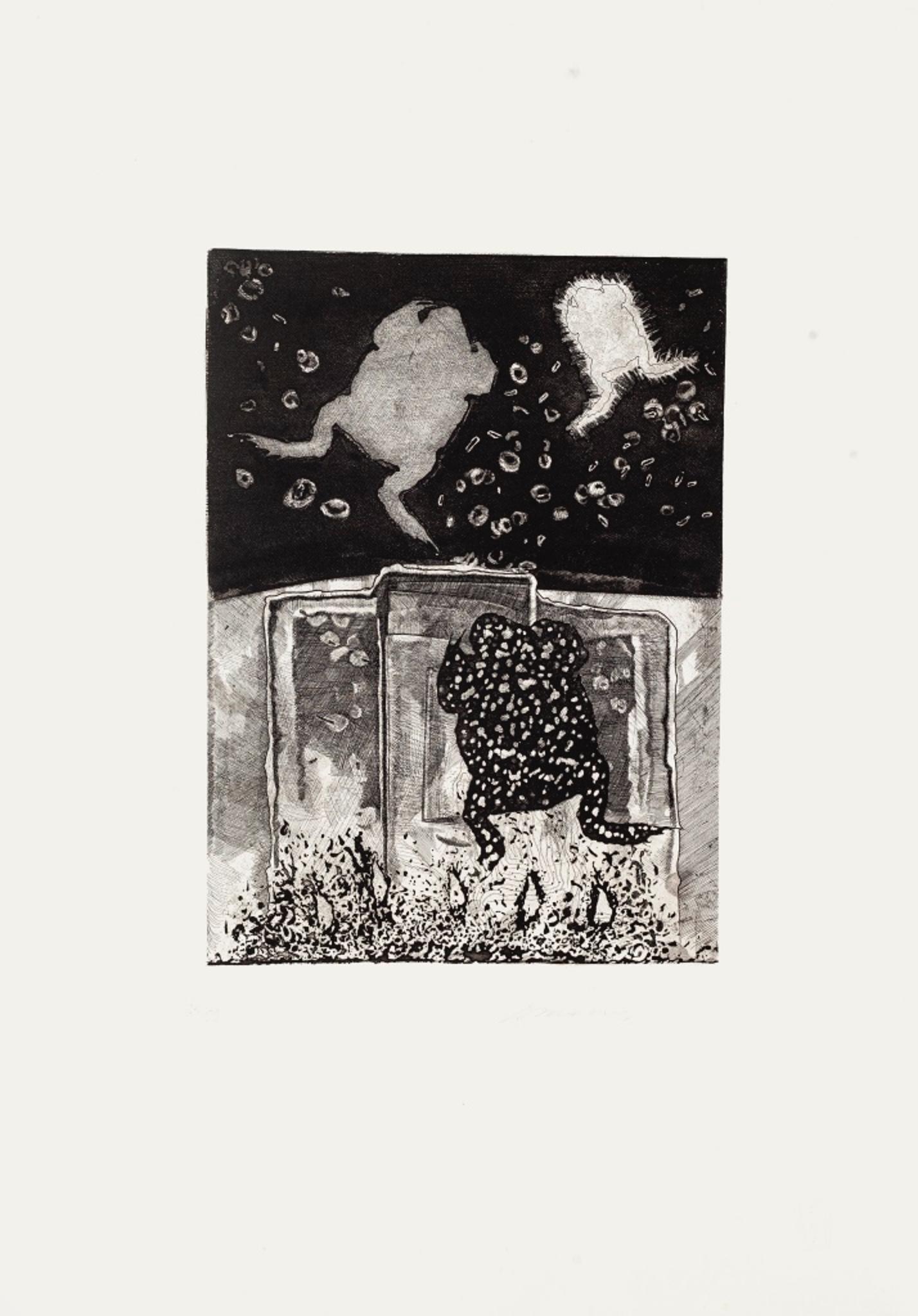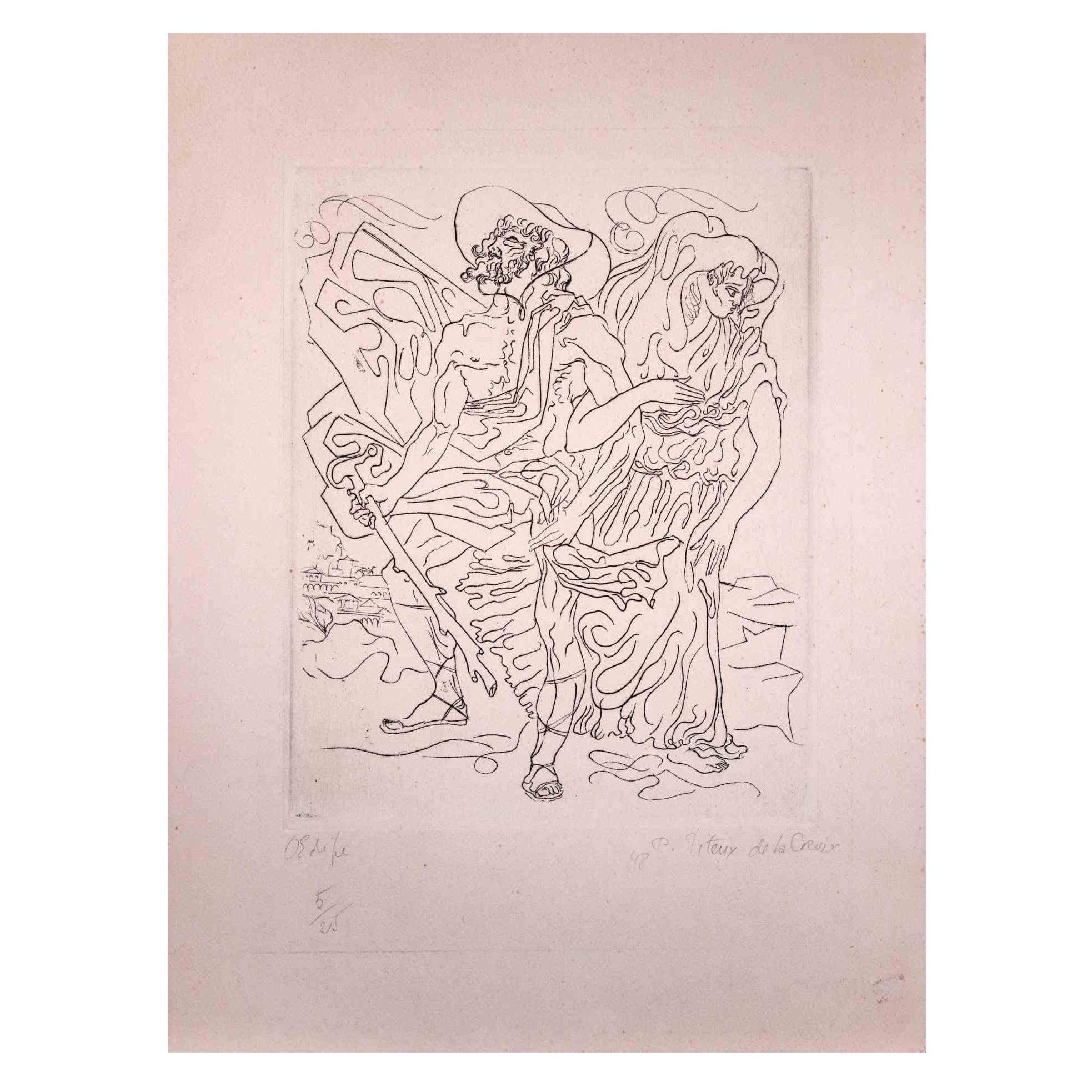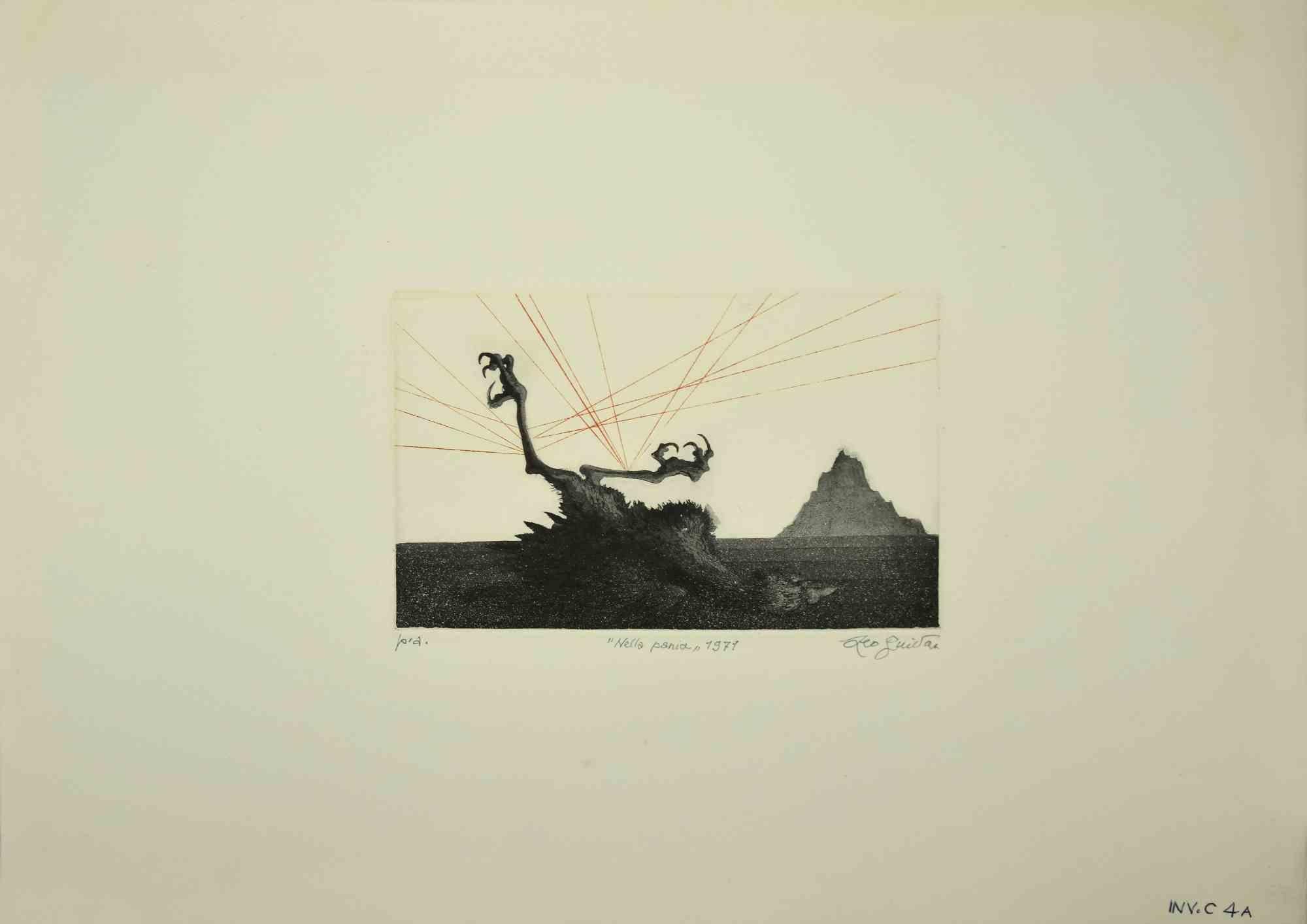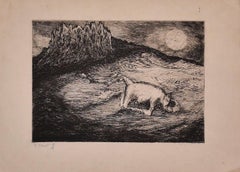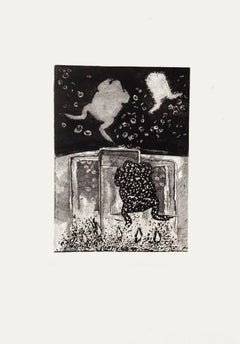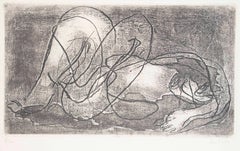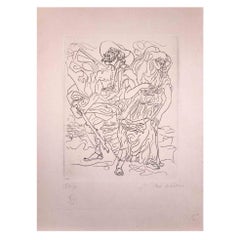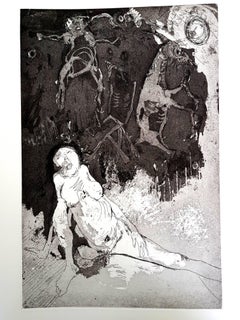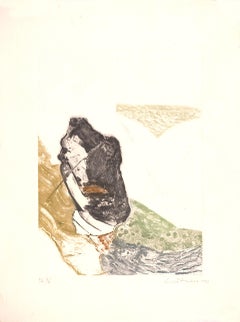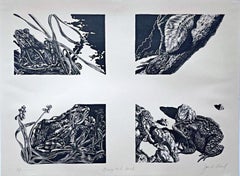Items Similar to Frog - l Etching by Marcel Guillard - 20th century
Want more images or videos?
Request additional images or videos from the seller
1 of 5
Marcel GuillardFrog - l Etching by Marcel Guillard - 20th century20th century
20th century
$237.11
£180.17
€200
CA$332.75
A$362.83
CHF 188.58
MX$4,343.56
NOK 2,391.96
SEK 2,240.52
DKK 1,523.62
About the Item
Frog is an original etching artwork, realized by Marcel Guillard (1896 -?).
The state of preservation is very good.
The artwork represents a lying down frog on the front and mountains with sharp peaks and a full moon on the background through black and white color, it is characterized by precise and soft strokes in a well-balanced composition, The artist masterly created a pleasurable dreamlike scenery.
- Creator:Marcel Guillard
- Creation Year:20th century
- Dimensions:Height: 10.83 in (27.5 cm)Width: 15.16 in (38.5 cm)Depth: 0.04 in (1 mm)
- Medium:
- Movement & Style:
- Period:
- Framing:Framing Options Available
- Condition:Insurance may be requested by customers as additional service, contact us for more information.
- Gallery Location:Roma, IT
- Reference Number:Seller: M-1081171stDibs: LU65036833752
About the Seller
4.9
Platinum Seller
Premium sellers with a 4.7+ rating and 24-hour response times
1stDibs seller since 2017
7,810 sales on 1stDibs
Typical response time: 1 hour
- ShippingRetrieving quote...Shipping from: Monaco, Monaco
- Return Policy
More From This Seller
View AllFrog - Original Etching on Paper by Marcel Gaillard - 1950s
By Marcel Gaillard
Located in Roma, IT
Frog is an original etching on paper by Marcel Gaillard.
The state of preservation of the artwork is good.
Numbered on the lower left 1/1.
Sheet dimension : 28 x 38 cm.
The artwo...
Category
1950s Figurative Prints
Materials
Etching
$165 Sale Price
30% Off
Frogs - Original Etching by Maurizio Ermani -1980s
Located in Roma, IT
Frogs is an original Contemporary artwork realized by the Italian artist Maurizio Ermani (Urbino, 1955) in 1980s.
Original B/W Etchin on Paper. Image Dimensions: 39.5 x 29.5 cm.
H...
Category
1980s Contemporary Animal Prints
Materials
Etching
Nu - Original Etching by J. Fautrier - 1941
By Jean Fautrier
Located in Roma, IT
Hand signed. Artist's proof.
Image Dimensions : 16 x 28 cm
This artwork is shipped from Italy. Under existing legislation, any artwork in Italy created over 70 years ago by an artis...
Category
1940s Modern Abstract Prints
Materials
Etching
Edipe - Original Etching by Paul Titeux de La Croix - 1948
Located in Roma, IT
Edipe is an original Etching print realized by the artist Paul Titeux de La Croix.
Hand Signed and dated on the right corner. On the left corner titled "E...
Category
1940s Modern Figurative Prints
Materials
Etching
Ex Libris Giorgio Balbi - Etching - Mid-20th Century
By Franco Rognoni
Located in Roma, IT
Ex Libris For Giorgio Balbi, realized by an artist of the mid-20th Century.
It includes passepartout, 30 x 24 cm.
Hand signed on the lower margin.
Good conditions.
Category
Mid-20th Century Modern Figurative Prints
Materials
Paper, Woodcut
$232 Sale Price
30% Off
Nella Pania - Original Etching by Leo Guida - 1971
By Leo Guida
Located in Roma, IT
Nella Pania is an original artwork realized in 1971 by the italian Contemporary artist Leo Guida (1992 - 2017).
Original colored etching on ivory-colored cardboard.
Hand-signed...
Category
1970s Contemporary Figurative Prints
Materials
Etching
You May Also Like
Frogs and Toads, Realist Black and White Lithograph by Jack Beal
By Jack Beal
Located in Long Island City, NY
Artist: Jack Beal, American (1931 - 2013)
Title: Frogs and Toads - Conspiracy: The Artist as Witness
Year: 1971
Medium: Lithograph, signed and numbered i...
Category
1970s Realist Figurative Prints
Materials
Lithograph
Jean Jansem - Original Etching
By Jean Jansem
Located in Collonge Bellerive, Geneve, CH
Jean Jansem - Original Etching
Title: Loneliness
Dimensions: 40 x 30 cm
Edition of 175
Paper: vélin de Rives
1974
Unsigned and unumbered as issued
Category
1970s Modern Figurative Prints
Materials
Etching
Lucio Muñoz Martinez Spanish Artist Original Hand Signed engraving 1983
Located in Miami, FL
Lucio Muñoz Martinez (Spain, 1929-1998)
'Discurso para navegantes I', 1983
engraving on paper
18.2 x 13 in. (46 x 33 cm.)
ID: MUÑ1114-011-007
Hand...
Category
1980s Contemporary Prints and Multiples
Materials
Paper, Engraving, Screen
Frogs and Toad, Signed lithograph (AP), from Conspiracy: The Artist as Witness
By Jack Beal
Located in New York, NY
Jack Beal
Frogs and Toad, 1971
Hand signed in pencil by Jack Beal, annotated AP
One-color lithograph proofed by hand and pulled by machine from a zinc plate on Arches buff paper with deckled edges at the Shorewood Bank Street Atelier
Stamped, hand numbered AP, aside from the regular edition of 150 Stamped on reverse: COPYRIGHT © 1971 BY JACK BEAL, bears blind stamp
18 × 24 inches
Unframed
18 x 24 inches
Stamped on reverse: COPYRIGHT © 1971 BY JACK BEAL, bears distinctive blind stamp of publisher (shown) Publisher: David Godine, Center for Constitutional Rights, Washington, D.C.
Jack Beal's "Frogs and Toads" is a classic example of protest art from the early 1970s - the most influential era until today. This historic graphic was created for the legendary portfolio "CONSPIRACY: the Artist as Witness", to raise money for the legal defense of the Chicago 8 - a group of anti-Vietnam War activists indicted by President Nixon's Attorney General John Mitchell for conspiring to riot during the 1968 Democratic National Convention. (1968 was also the year Bobby Kennedy was killed and American casualties in Vietnam exceeded 30,000.) The eight demonstrators included Abbie Hoffman, Jerry Rubin, David Dellinger, Tom Hayden, Rennie Davis, John Froines, Lee Weiner, and Bobby Seale. (The eighth activist, Bobby Seale, was severed from the case and sentenced to four years for contempt after being handcuffed, shackled to a chair and gagged.) Although Abbie Hoffman would later joke that these radicals couldn't even agree on lunch, the jury convicted them of conspiracy, with one juror proclaiming the demonstrators "should have been shot down by the police." All of the convictions were ultimately overturned by the 7th Circuit Court of Appeals.
This lithograph has fine provenance: it comes directly from the original Portfolio: "Conspiracy The Artist as Witness" which also featured works by Alexander Calder, Nancy Spero and Leon Golub, Romare Bearden Sol Lewitt, Robert Morris, Claes Oldenburg, Larry Poons, Peter Saul, Raphael Soyer and Frank Stella - as well as this one by Jack Beal. It was originally housed in an elegant cloth case, accompanied by a colophon page. This is the first time since 1971 that this important work has been removed from the original portfolio case for sale. It is becoming increasingly scarce because so many from this edition are in the permanent collections of major museums and institutions worldwide.
Jack Beal wrote a special message about this work on the Portfolio's colophon page. It says, "In 1956, shortly after Sondra and I moved to New York, two friends were arrested and jailed for protesting air-raid drills. From them and their friends came our education. This work is dedicated to them and their families. "In Memory of Patricia McClure Daw and AL Uhrie" - This print was made for their children.
Jack Beal Biography:
Early in his career Walter Henry “Jack” Beal Jr. painted abstract expressionist canvases, because he believed it was “the only valid way to paint.” By the early 1960s he totally altered his approach and fully repudiated abstraction. Turning to representation, he painted narrative and figurative subjects, often enhanced by bright colors and dramatic perspectives.
Beal was born in Richmond, Virginia, and from 1950 to 1953 he attended the Norfolk Division of William and Mary College Polytechnic Institute, (now Old Dominion University) where he studied biology and anatomy. Shifting gears, he sought art training at the School of the Art Institute of Chicago where he focused on drawing, and met his wife, artist Sondra Freckelton. His art history instructor encouraged her students to paint in the manner of established artists, and to that end he frequented the Institute’s galleries. For Beal this was significant: “Until I saw pictures of real quality I had tended to think of painting as just so much self-indulgent smearing around, but when I saw masterpieces by Cézanne and Matisse, and other painters of similar stature, I was bowled over; suddenly I realized the force of art.”
After spending three years (1953–1956) at the Art Institute, Beal concluded his studies there without getting a terminal degree, thinking it was only useful if he wanted to teach, which, at the time, he did not. He also took courses at the University of Chicago in 1955 and 1956. During this period he married Freckelton, a fellow student and sculptor who began her career working in wood and plastic. Together they moved to New York’s SoHo District before its transformation from a wasteland of sweatshops and small factories into an arts district. They were active with the Artist Tenants Association which was instrumental in getting zoning laws changed so that artists could live and work in the well-lit lofts.
Embracing what came to be called “New Realism,” Beal initially painted an occasional landscape as well as earthy-toned still lifes which consisted of jumbled collections filled with personal objects. His signature style started with a series of female nudes—all modeled by Freckelton—based on Greek mythology. These were large canvases with flat paint surfaces, dramatic foreshortening, and unusual perspectives. He further enlivened them with vivid colors, stark lighting, and dynamic patterns derived from textiles and overstuffed furniture. He stopped painting nudes after two episodes. The first came as he was loading a canvas of his naked wife onto a truck in lower Manhattan; several laborers walked by and started to fondle and kiss the painting. On the one hand he felt his wife had been violated, while on the other he was pleased that his realism was so convincing. The second occurred after a solo exhibition in Chicago at which the reception had been sponsored by Playboy magazine. A few days later he was approached by a publicist and asked if Playboy bunnies could be photographed in front of his paintings. He refused.
Some portrait commissions came Beal’s way, but he preferred only portraying friends. More significant were four large murals on the History of Labor in America, the 20th Century: Technology (1975), which he undertook for the headquarters of the United States Department of Labor in Washington. Following a historical timeline, the themes were: colonization, settlement, nineteenth century industry, and twentieth century technology. The unveiling ceremony was attended by government officials and Joan Mondale, an arts advocate and wife of the vice-president. The reviewer for the Washington Post wrote enthusiastically: “They’re heartfelt and they’re big (each is 12 feet square). Their many costumed actors (the Indian, the trapper, the scientist, the hardhat, the capitalist in striped pants, the union maid, etc.) strike dramatic poses in dramatic settings (a seaside wood at dawn, an outdoor blacksmith’s forge, a 19th-century mill, a 20th-century lab). The lighting is theatrical. Beal’s compositions, with their swooping curves and bunched diagonals, are as complicated as his interwoven plots.” To accomplish the murals Beal assembled a team of assistants and models, much in the manner of Renaissance masters, which included artist friends and Freckelton. who by then was painting brightly colorful still lifes.
A second mural commission ensued from New York City’s Metropolitan Transit Authority for two twenty-foot long installations for the Times Square Interborough Rapid Transit Company subway station. Beal’s designs for The Return of Spring (installed in 2001, three days after the terrorist attacks in New York, Washington, DC and Philadelphia) and The Onset of Winter (installed in 2005), Beal captured the appearance of his models in an oil painting made to the scale of the intended mosaic. A collaboration with Miotto Mosaics, the canvases were shipped to the Travisanutto Workshop, in Spilimbergo, Italy, where craftsmen fabricated the design to glass mosaics. The Return of Spring depicted construction workers and other New Yorkers in front of a subway kiosk and an outdoor produce market and in The Onset of Winter, a crowd watches a film crew recording a woman entering the subway as snow falls against the city’s skyline. Harkening back to some of his early nudes based on Greek myth, Persephone, goddess of fertility and wife of Hades, appears in both. The symbolism is pertinent, since she spent six months each year below ground.
Although he disparaged teaching early on, Beal and Freckelton offered four summertime workshops on their farm in Oneonta, New York. He was an instructor at the New York Academy of Art, a graduate art school he helped to establish in 1982. Returning to Virginia, he taught at Hollins College...
Category
1970s Realist Animal Prints
Materials
Lithograph
Vladimir Vlady Kibalchich Russian Artist Original Hand Signed engraving 1991 n7
Located in Miami, FL
Vladimir Vlady Kibalchich (Russia, 1920-2005)
'Untitled', 1991
engraving on paper Velin Arches 300 g.
22.1 x 15.2 in. (56 x 38.5 cm.)
Edition of 50
ID: VLA-307
Hand-signed by author
Category
1990s Contemporary Prints and Multiples
Materials
Paper, Engraving, Screen
"Hunting, " Original Etching and Aquatint signed by Molly McKee
By Molly McKee
Located in Milwaukee, WI
"Hunting" is an original etching and aquatint by Molly McKee. The artist signed the piece in the lower right, titled it lower center, and wrote the edition number (2/10) in the lower left. It depicts a few abstracted human figures in McKee's surreal and horror-inspired style.
11 3/4" x 9" art
24 7/8" x 17 1/2" frame
This surreal etching...
Category
1990s Surrealist Figurative Prints
Materials
Etching, Aquatint
More Ways To Browse
Frog Art
Tan Tan Bo
Tarkay Serigraphs Signed
Tarot Card Box
Thank You For The Wonderful Destiny
The Emperor Jones
The Goddess Dali
The Little Beggar
The Vintage Fort
The Wailing Wall Dali
Thomas Mcknight Venice
Tim Doyle
Tran Nguyen Hieu
Tranquillo Marangoni
Trolley Banksy
Utagawa Kunisada 1857
Vasarely Juggler
Velvet Elvis
